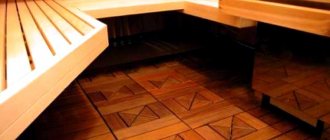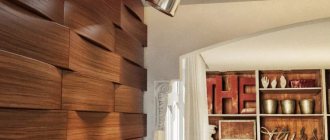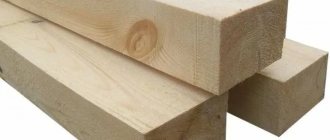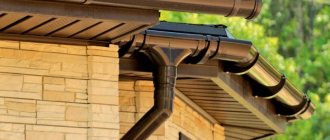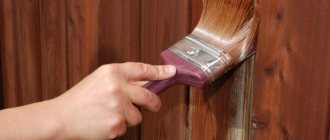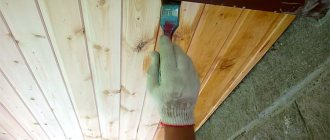After the floorboards have been laid and the lining of the ceiling and walls of the room has been sewn, the stage of choosing a coating or impregnation for the wood, especially the lower tier, begins. You cannot even try to cover the floor in a bathhouse with ordinary varnishes and paints; a completely different environment, high humidity and temperature can destroy the wood within a few months of service.
Simple varnish can protect floorboards as well as paint
The main areas in the bathhouse and the features of using the floors in them
The bathhouse is divided into several thematic areas:
- Steam room.
- Washing room.
- Waiting room.
- Rest room.
There can be even more zones, for example, sometimes a shower and sauna are added. Conversely, some sectors can be combined and reduced to two - an area for direct procedures and a locker room/rest room. Therefore, the whole question of how to cover the floor in a steam room of a bathhouse comes down, first of all, to the degree of exposure to harmful factors in a particular place.
The most extreme conditions for the floor are created in areas of high humidity and temperature, as well as from exposure to detergents. At the same time, in the waiting room these destructive factors are practically excluded. However, the proximity to the bathhouse and the street always carries excess moisture. Therefore, even here it is necessary to use special processing tools.
The main factors of material destruction are:
- Heat.
- High humidity.
- Water.
- Formation of mold and mildew.
- Detergents.
- Temperature changes during the cold season.
Destruction of a wooden floor in a bathhouse by rot Source ytimg.com
Important! When choosing a treatment product, it is first necessary to take into account the likely harm to human health, and only then the degree of protection of the materials.
Bathhouse, steam room, washing room
Premises in direct contact with water and heat are exposed to the most destructive factors. Therefore, first of all, you need to know how to cover the floor in the bathhouse and steam room. As a rule, there is a special antiseptic for this. However, the effectiveness of the products used depends not only on the composition, but also on the structure and material of the floor surface.
In the steam room and washing area, the floor is made of wood or concrete. The first option has two varieties:
- Torrential . It is lined with boards located at a short distance from each other. Water naturally drains down into the gaps that form during bathing procedures.
- Solid . It also has a wood base, but unlike the version described above, water does not pass through the surface, but goes into the sewer system through specially equipped drains.
Water-filled floor in the bathhouse Source ytimg.com
The concrete floor in the bathhouse is continuous and sloped to facilitate water removal. A wooden sheathing is usually placed on top of the screed. A metal flat bowl for catchment can be additionally installed at the bottom of it. In addition, tiles made from natural or artificial materials are often laid at the final stage of finishing.
Important! The use of a wooden or concrete floor in a bathhouse in winter requires insulation. This is only possible with proper hydro- and vapor barrier. At the same time, all structural elements must be treated with an antiseptic to eliminate the processes of rotting, mold and mildew.
Dressing room, rest room
The steam room and washing room are only half of the bathhouse, because in many ways the effect of the procedures depends on the correct subsequent rest. Therefore, it is also important to know what the floor in the dressing room should be like - what is best to make it from in order to provide all the necessary conditions for the relaxation room and locker room.
Insulation of the floor in the dressing room with expanded clay Source banyabest.ru
See also: Catalog of companies that specialize in the construction and repair of baths and houses
The floor in the dressing room is made based on how the bathhouse itself is used. If it is fully used all year round, then the floor surface must be insulated. The peculiarities of the operation of this room are that steam, splashes, dampness, and temperature contrast will also be constantly present in it. They are protected by a properly selected coating and a well-assembled structure - double flooring, insulation, hydro- and vapor barrier.
Advice! For comfortable use of a bathhouse at any time of the year, it is important to know not so much how to make a floor in a dressing room, but how to properly insulate it. When leaving the steam room to relax, a person can easily become hypothermic from contact with a cold floor covering. The optimal modern solution is the installation of heated floors. As a technical solution, heating can occur through pipes with water heated from a sauna stove.
Modern heated floors in the bathhouse Source pikabu.ru
Introduction to antiseptic
Everything that is made from natural wood must be treated with a special agent that prevents decomposition and destruction of the fibers - an antiseptic.
As you know, the bathhouse maintains high temperature and humidity almost all the time. Such conditions are ideal for wooden floors and other surfaces to begin to become covered with mold, mildew, and rot. Pests can live in them.
Rules for choosing an antiseptic:
- Belonging to a well-known manufacturer.
- The composition must be designed specifically for baths.
Types of impregnations:
- Water soluble. This product is best suited for application to walls in the dressing room and rest room.
- Antiseptic with organic solvent. Gives the surface increased moisture resistance and strength. Can be used for external and internal work. This impregnation can also be used to treat steam room floors.
- Oil based. Suitable for areas where there is no change in temperature and humidity.
- Combined. They allow you to protect the tree not only from rotting, but also from fire.
Before applying the antibacterial composition, the wood is cleaned. It also shouldn't be wet.
The product should be applied in two or three layers, paying special attention to the joints and cuts. If damage from insects has been noticed, you should use a special alcohol-based composition.
It is poured into the passages using a syringe, applying a small amount to the area around.
It is important to remember that any, even very high-quality antiseptic, is washed out over time. This is especially true for baths
To extend its lifespan, the floor is coated with varnish - but not ordinary varnish, but a special water-based one.
What, when and with what to start processing
Before you start looking for a solution to the question of how to cover the floor in the bathhouse vestibule, you need to find out which places to treat first and which ones secondarily. You need to start with the structural elements located at the very bottom - the floor beams. This is done at the stage of construction of the log house. It is advisable to pre-process and dry them - even before placing them in the lower crowns.
You need to use special antiseptics for baths for this purpose. The number of layers depends on the instructions, manufacturer and component composition. However, in most cases it is recommended to impregnate the beams at least 2-3 times, after each complete drying of the previous layer.
Here it should be taken into account that this structural element will not be accessible during operation and will be subject to maximum exposure to destructive factors. In addition, the durability of the flooring will depend on its preservation.
Creating a double sex in a bathhouse Source blog-potolok.ru
Important Tips
When choosing a paint and varnish mixture, you need to pay attention not only to the color and period of its service, but also to the following points:
- Specifics of wood covering. To process different types of wood, it is necessary to use different coloring compounds, which is determined by the structure and density of the material;
- Intensity of use. Oil mixtures have the greatest wear resistance, so they can be used in rooms with a high degree of load on the floors;
- Service period. The paint that will last the longest in a bathhouse is the one that is most resistant to moisture, i.e. based on acrylic or water emulsion.
It is worth considering that a change in paint color sometimes indicates imminent cracking of the coating. To prevent the wood from getting wet, it is advisable to re-paint the floors.
Choice of impregnation
In order to reliably protect the floor structure from rot, fungus and other destructive factors, you need to know exactly how to cover a wooden floor in a bathhouse - namely, what types of impregnation exist for this. Today on the market you can buy compositions of the following 4 modifications:
- Water soluble . Suitable for rooms where direct exposure to water is excluded - dressing room, rest room, locker room.
- Organic solvent based . Ideal for use in steam rooms, washing rooms, showers - where there is maximum surface contact with water.
- Oil solution . Limited in use - suitable for areas with slight differences in humidity and heat.
- Combined . It has a universal set of properties - water resistance, antiseptic, fire protection.
Recommendation! Before applying impregnation, a long-painted, whitewashed or varnished surface should be cleaned down to the wood layer, carefully sweep away the shavings and sawdust and dry.
Colored impregnations for wood Source instrumentgid.ru
Features of the use of paints
Before painting, the floor surface is sanded and degreased.
Painting a rest room does not have any special restrictions in the choice of tinting compounds. Can water-based or oil-based mixtures be used to paint the floor? Since the rest room does not have a harsh microclimate, almost any type of paint and varnish mixtures can be used to treat the floor.
To prevent the painted surface from starting to crack within a couple of months after application, you need to paint the rest room as follows:
- The coating is cleaned of dirt and oil stains;
- The wood is first sanded to improve the adhesion of the paint to the floor surface;
- Before use, stir the paint and varnish mixture thoroughly;
- The paint is applied to the coating in several layers using a soft brush or roller;
- Oil stains that appear on the surface are removed with a sponge.
Selecting a Finish
Knowing how to cover the floor in the dressing room or the bathhouse itself will not only give the finish a modern, stylish look, but also preserve the surface from premature destruction. Varnishes and paints are used for finishing.
Varnish coating
The floors in the bathhouse are varnished at the final stage - after the previously applied impregnation has dried. In this case, you need to select either a composition specially designed for bath rooms, or one that does not include toxic substances and does not release their dangerous derivatives when heated.
Positive effects of varnishing the floor in a bathhouse:
- Protection of the flooring from mechanical damage (abrasion, drying out, cracking).
- Increasing the resistance of wood to physical and chemical factors - temperature changes, moisture, detergents.
- Giving the material antiseptic properties - which will provide it with protection from insects, microorganisms and fungi.
Impregnating the floor with varnish Source nadoremont.com
Apply varnish to the surface only after it has been thoroughly cleaned and dried. For even distribution it is better to use a roller or brush.
Painting
It is permissible to paint bath floors only using special paint. It should not contain harmful substances, including their release under the influence of hot water, air and radiation from heating devices.
When choosing paint, you need to take into account both the operating conditions of the room and the type of wood. For example, for coniferous species it is extremely undesirable to use compounds that form a dense, hard surface layer after drying. This can only worsen the situation with the formation of rot.
Advice! Oil paints are well suited for painting wooden bath floors. Among other advantages, they are distinguished by a wide range of colors, form a durable surface layer after drying and keep the natural texture of the boards visible.
Material requirements
It is desirable that the color of the paint emphasizes the texture of the wood and does not overlap its wood pattern.
Which paint is suitable for painting floors in a “damp” room? Paint and varnish products intended for use in extreme conditions must have the following qualities:
- temperature stability;
- resistance to moisture;
- non-toxic;
- antifungal properties;
- resistance to mechanical damage.
In addition, it is desirable that the paint color emphasizes the texture of the wood and does not overlap its wood grain. To paint a concrete floor, you need to purchase compounds with dust-removing properties and good adhesion to mineral substrates. Otherwise, the protective layer will crack very quickly.
Proper processing of lining
Having decided how to cover the lining in the steam room of the bathhouse, you can proceed to the processing itself. To perform high-quality impregnation that will last a long time, we recommend that you read the following instructions:
Processing lining in a steam room begins with preparing the wood itself. Clean it from various contaminants with sandpaper or other suitable method. It is also recommended to wash the boards with an aqueous solution of soda (300 g of soda per 10 liters of water); Next, you need to degrease the surfaces. Remember that not only the lining itself is impregnated, but also the frame to which it is attached; Sand surfaces with pumice to obtain a smooth finish; Next, you need to apply an antiseptic that will protect the wood from fungus and mold; Now you can saturate the lining
When choosing impregnation for the dressing room, pay attention to the humidity of the air in it, as well as the temperature of the steam. If the indicators are approximately equal to the indicators inside the steam room, then it is necessary to use the same impregnation.
By doing all the work correctly, you can achieve an excellent result, as in the photo.
Types of premises
Fortunately, there are not many rooms in the bathhouse (in a standard one). Therefore, we will quickly go through the options of what paint to paint the inside of the bathhouse.
Steam room
This is the most problematic room. Many people believe that there is no need to paint anything there at all, but the price for such a decision is rapid darkening of the wood (and almost everyone has a steam room traditionally made of wood or lined with wood), cracking of the wood (this happens more often from poor ventilation during drying), susceptibility to rotting and mold damage (linden and aspen are very unstable species).
So the absence of any protective coatings, on the one hand, should be considered environmentally friendly, and on the other, costly in terms of future repairs.
We believe that a compromise is possible: there are absolutely safe impregnations that protect wood, preventing moisture and dirt from being absorbed. If you have doubts about whether it is worth using drying oils, take paraffin oil or another ready-made product intended specifically for the steam room.
You can paint the inside of the steam room with both paints and varnishes, but let them be water-soluble paints. And it would be nice if the label mentioning GOST standards stated that this composition is applicable in the steam room.
Washing
Both silicone and acrylic paints are suitable here. In general, everything that patiently endures the effects of moisture.
Other paints will crack and peel off in pieces under constant exposure to water.
ADVICE! Water dispersions do not tolerate frost well: if the water in the paint freezes, then after defrosting it will lose its quality. Therefore, buy them in the warm season, produced recently.
Impregnations and varnishes are also suitable for painting a sink. Again we draw your attention to scuba gear.
These rooms are the least demanding on the composition of paints, so it is best to proceed from budgetary considerations. If it doesn’t run out, you can give yourself a gift and use water-soluble paints again, otherwise, choose a paint that is suitable in color, dullness and durability of the coating from cheaper ones.
Of course, in the second case, it is better to paint when it is possible to ensure the best ventilation and the absence of people. Don't forget to use respiratory protection.
IMPORTANT! Remember that enamels and alkyd paints are fire hazards, but water-soluble paints are not.
Rating of the best funds
Let's look at several factory-made products for impregnating bath shelves.
Tikkurila Supi Arctic
Composition from a well-known manufacturer of paints and varnishes from Finland. The main ingredient is acrylate resin. It forms a thin protective layer on the tree that does not allow moisture to pass through and ensures the safety of the wood.
When dry, acrylate resin is very flammable, so the product can be considered fireproof.
The drug is suitable for both Russian baths and saunas.
The main disadvantage of Supi Arctic is that it does not allow the tree to release essential oils into the steam room air.
The cost of a 0.9 liter can is about 500 rubles.
Sauna Natura Saunasuoja
The composition is based on a polymer substance that is absorbed deep into the wood and tightens its fibers, thereby creating reliable protection against moisture. It also contains antiseptics that prevent the proliferation of pathogens, fungi and mold.
A 2.7 liter bucket of product costs approximately 4,000 rubles. The price is high, but quite justified - Sauna Natura Saunasuoja has a long service life and good wood protection.
The impregnation will have to be changed only after 5–6 years. At the same time, rotting and mold are practically eliminated.
Tikkurila Supi Lattiaoljy
An emulsion that consists of linseed oil and tar oil with a small amount of polymer additives. The components also include antiseptic agents that prevent the development of bacteria, fungi and mold.
Suitable not only for protecting shelves, but also for treating walls, floors and ceilings in a steam room.
A 0.9 liter jar of emulsion costs about 1,000 rubles.
Zhivitsa BioGrunt
Domestic protective agent for impregnating shelves in a bathhouse.
Consists of the following ingredients:
- natural linseed oil;
- pine resin;
- turpentine;
- silver.
Linseed oil and turpentine provide reliable protection of wood from moisture, silver prevents the development of microorganisms, and oleoresin gives the shelves a pleasant pine aroma, which becomes even richer when the steam room is heated.
A 0.4 liter container of the composition costs about 700 – 800 rubles.
Neomid Sauna Oil
It is an oil emulsion for treating shelves, walls and ceilings in a bathhouse. Unlike most other formulations, it is made not from natural, but from synthetic oils.
Thanks to this, it is cheaper than analogues. Provides reliable protection against moisture. Absolutely safe for the human body. A 0.25 liter bottle of the product costs about 200 - 300 rubles.
Pinotex Lacker Sauna 20
Water-soluble acrylic emulsion varnish. When dry it becomes moisture resistant. Tolerates exposure to high temperatures well. The composition includes antiseptic agents that prevent the development of fungi and bacteria. The cost of a 1 liter can is 500 – 600 rubles.
Biotex
This product is a mixture of antiseptics that prevent the development of bacteria that cause rotting. The composition protects against water and high temperature due to the presence of wax and paraffin among the components. A 0.9 liter jar of the product costs 300 – 400 rubles.
VGT
The product is an acrylic varnish with special additives that make it moisture and heat resistant
It contains wax, which makes the surface coated with the product more pleasant to the touch, which is especially important for bath shelves. A 2.2 liter container costs 700 – 800 rubles
Teknos SATU SAUNAVAHA
Finnish product based on natural beeswax. It also contains antibacterial agents and substances that promote the absorption of the composition into the wood. The cost of a 0.9 liter can is about 700 rubles.
Burnishing an iron stove
Burnishing is a method of giving a dark shade to an iron stove in a bathhouse without using paint. The surface is coated with an oxide that is resistant to moisture and temperature. At the first stage, the metal walls are cleaned with a brush, grinder or sandpaper until shiny, removing the oxide. Treat the device with a degreaser or solvent to remove any remaining abrasive and rust.
Prepare a solution in which 5 g of butyl alcohol and 150 g of phosphoric acid are added per liter of water. The composition is mixed and coated on the iron surfaces of the sauna stove. As soon as the metal is dry, it is washed with dissolved laundry soap. In order for the surfaces to acquire the desired shade, the oven is heated to 150 °C and caustic soda is sprayed from a spray gun. The cold method of bluing an iron furnace uses a mixture of olive oil and antimony III chloride. The composition is applied in two layers at intervals of 48 hours. The first layer is removed with a woolen rag.
Arrangement of rough flooring
The subfloor is intended to support the insulation layer between the subfloor and the facing flooring. It is made from short pieces of thin boards nailed to the joists on the underside.
The subfloor is not visible from the outside and is not subject to stress when walking. Therefore, it is not at all necessary to use a high-quality floorboard with a length equal to the length of the bathhouse.
Attention! For the subfloor, it is rational to use scraps of boards obtained during the construction of other elements of the bathhouse. There is especially a lot of such waste during the construction of panel baths
The subfloor is assembled from unplaned boards or from others that are available. Also, the board does not have to be tongue-and-groove. A regular edged one will do.
Typically, a subfloor is constructed in a bathhouse in a recreation room. In the steam room, its function is performed by a concrete surface that collects water (waste system). Antiseptic treatment for subfloors is required.
Types of paint and varnish products
Some types of materials contain formaldehydes, which begin to evaporate when exposed to high temperatures. Which paint is best for treating flooring in a bathhouse? Before purchasing coloring compounds, you need to familiarize yourself with their classification. Based on the method of painting, paints can be divided into two types:
- Construction and household. Easy-to-use formulations that are sold ready-made. They are cheaper than professional ones, but the quality of such materials is much worse;
- Professional. Difficult to use materials, the preparation of which is impossible without knowledge of technological maps for paint and varnish products. Professional floor paint contains emulsions that significantly increase the service life of the protective layer.
Is it possible to use regular coloring compounds to treat the floor in a bathhouse? Some types of materials contain formaldehyde, which, when exposed to high temperatures, begin to evaporate from the surface of the coating. They can only be used in the rest room, since the air temperature in it rarely rises above 27-30 degrees. In the sink and steam room, the temperature can rise to 80-90 degrees, so cheap paint in them will begin to release harmful chemicals, which is fraught with negative consequences for health.
Which vapor barrier to choose for the ceiling, its types and cost
Wooden floors leaking
General scheme for creating a floor in a bathhouse
The simplest floors. The design of leaking floors does not provide insulation, so they are used either in the south or in the warm season, in the country. There is no water drainage system as such in the design of such a floor. Waste water is most often drained directly onto the ground. But, if the soil is clayey, then you will have to install a water drainage system. To do this, we make a reservoir, as described in the section describing the construction of concrete floors. There is no need to bring the pipe into the bathhouse. The design of the floors does not require a special drain hole.
If we lay the logs on the ground, then perform the following steps:
- we treat the logs with an antiseptic;
- level the site;
- add gravel;
- we compact the site. On clay soils, it is imperative to slope towards the reservoir;
- install support posts for the logs;
Supports for logs
Installation on the ground on posts
- we lay the logs. Step – 50 cm;
Joists on supports
- lay the floor. Leave a gap between the boards, floor and wall. The gap is up to 3 mm. Water will flow through these gaps. We do not attach boards to the joists. Leaking floors are removed from the joists and taken out to dry after using the bath. The cushion under the joists and the joists themselves must be laid so that the lower edge of the floor is higher than the upper edge of the foundation (basement).
The service life of such floors is short. They will last no more than five years.
Correct sequence of installation of wooden floors
When installing a wooden floor, certain standards must be strictly observed, and calculations must be made accurately and efficiently. For example, too large a distance between the joists will lead to constant squeaking, and the absence of a small gap between the floorboards will cause damage to the entire flooring when the wood begins to dry out.
The boards are laid directly on the logs, which in turn must be installed on small supports. At the points of contact between the joists and the foundation, it is necessary to install an additional insulating layer; inexpensive roofing felt is suitable for this purpose, but at least two layers must be used. Also, some home owners use melted bitumen, but its service life is much shorter than that of roofing felt.
Sequence of installation of a wooden floor:
- Installation of wooden supports. The supports are the basis for further laying of the logs. For floorboards of any thickness, a beam with a cross-section of 25 cm is used. But when the thickness changes, the distance between the supports increases or decreases. The ratio of the board to the embedded supports:
- with a board 19 mm thick, embedded supports should be installed at least every 70 cm;
- with a board 22 mm thick, embedded supports should be installed at least every 80 cm;
- with a board 29 mm thick, embedded supports should be installed at least every 90 cm.
You should know that wooden supports must also have a foundation; usually it is made of concrete, but some owners of private houses prefer to simply install and compact a small embankment.
- Underground installation. If the tree is not mounted to a concrete floor, but there is earth underneath it, then you just need to find out the quality of the soil. If the soil is crumbly and can act as a filter, then it will be enough to make a backfill of gravel; you can also make a mixture of gravel and sand.
The thickness of the layer should be at least 25 cm, but 10-12 cm should be left free before the lag. If the owner of the house does not plan to create a leaking drain, then the entire surface of the earth can be covered with expanded clay. The distance from the expanded clay to the lag is called the ventilation gap and should be at least 15 cm.
- Installation of logs. The basic rule when laying joists is to maintain the ideal level; accordingly, it is necessary to select even material. This is due to the fact that the floorboard will be laid on the logs in the future. If the joists are not positioned horizontally, the entire floor will be uneven.
- Installation of floorboards. The floorboard can be mounted on fixed and precisely measured logs. To begin with, it should be laid and lightly baited, but not secured. The boards must be given time to dry, after which precise and final adjustments can be made. The distance between the boards should be left no more than 2-3 mm.
After completing all installation operations, you can install the plinth on the boards. It must be firmly fixed, without gaps, otherwise moisture may accumulate under the baseboard, which will lead to the appearance of mold or rot.
Installing a wooden floor will not take much time; it is enough to make correct and accurate calculations, otherwise the consequences will require repeating the entire procedure again. After installation is completed, the boards must be left for several days, and then you can confidently steam in your sauna.
Why is this necessary?
Painting concrete solves several problems at once:
- First of all, the concrete floor is painted to prevent dust. The surface of concrete gradually collapses even in literally greenhouse conditions - at stable temperature and humidity; the rate of surface destruction increases many times with fluctuations in these parameters.
So, in a bathhouse with its periodic heating there will be much more dust than in a constantly heated workshop;
In addition: dusting is greatly increased by mechanical wear of the floor and vibration. A car driving into a garage, a lathe running, a bar falling onto a platform - they all raise concrete dust.
- Painting or impregnation will significantly delay the time of the next repair. The notorious mechanical and temperature effects, uneven moisture (for example, melted snow from the roof of a car), fuel and electrolyte from the battery inevitably spilling onto the floor will sooner or later decorate the floor with chips;
- Finally, don't forget about aesthetics. In fact, who would like the dull gray color prevailing in the room?
Painting the stove
In addition to deciding what is the best way to paint the inside of the bathhouse, you should also take care of the design of the stove. As a result, this element of the steam room will not only provide warmth, but also serve as a beautiful interior detail.
Of course, the best option would be to use special enamels that can withstand temperatures up to + 600 o C. If this option does not suit you for aesthetic or economic reasons, the stove can be decorated in the old Russian style - whitewashed with chalk or lime.
Regardless of the material chosen, the surface must be prepared accordingly. The surface should be thoroughly plastered, getting rid of minor defects, irregularities and potholes. As a last resort, treat the seams between the bricks with a special clay mortar.
The stove in the bathhouse can be whitened with chalk or lime
Whitewashing with chalk
To do this you need to prepare a special solution:
- Place pieces of chalk in a bucket, fill them with water and leave for an hour.
- In a separate container, mix animal glue and water in proportions of 25:1.
- Combine both solutions and mix until a homogeneous composition is obtained.
To make the surface look more aesthetically pleasing, you can apply two layers. The next one is applied only after the previous one has completely dried.
Lime whitewash
You can prepare a solution from 1 kg of lime (slaked) mixed with 1.5 liters of water. You can add one teaspoon of drying oil, 25 grams of blue and a pinch of salt. This will give the whitewash an attractive bluish tint.
Useful video
Video about applying oil to a tongue-and-groove floor in a log house:
Well, we told you everything we knew about floors, and for those who are planning to or have already started decorating a bathhouse, we advise you to look at the section dedicated to the topic of painting.
The dressing room is a room that serves as protection from the entry of cold air from the street into the bathhouse. When you have to design a dressing room, you need to adhere to some rules.
If the bathhouse is small in size and there are no other functional rooms, then the dressing room can serve as a rest room, locker room, or hallway. Taking into account such factors, you need to think carefully about how to paint the floor in the dressing room, and what material to choose for this.
The main materials for finishing such a room are wood, paint and varnish.
In the dressing room, the floor provides a constant flow of water, which means that the floor surface must be warm, pleasant to the touch and for bare feet. This is a room where there is high air humidity and water drips onto the floor and seeps into the cracks. Having a cold floor in such a room is dangerous to health. Therefore, materials for construction and floor treatment must be selected carefully. They should not cool or heat up quickly. The best option is wood with additional coatings. But not all types of wood can be used for flooring. You need a tree that does not rot: oak, larch. You should also not experiment with compositions for painting and treating floors; it is better to stick to proven methods.
How to avoid rotting lags
For any wood, all protective compounds can be divided into two main classes. These are antiseptics (impregnations) and varnishes. The first ones are absorbed into the wood. The second form a protective film on the surface, but do not penetrate inside.
Interestingly, for the most effective protection, you can use both methods at once.
Floor joists in a bathhouse are a stressed structural element.
They require first grade wood and proper protection from rotting.
When choosing how to treat logs in a bathhouse, you need to make a compromise between the effectiveness of the antiseptic and its safety for humans. The choice of antiseptics for logs is much more extensive than for floors.
The fact is that the logs are located outside the bathhouse and they are not exposed to hot water, like the floor. For them, you can use a wide range of antiseptics that are intended for use outside homes.
About the tools
A wide brush, rollers, a spray bottle - anything will do. To finish the seams, use a thin brush.
But if you follow the advice of experts, then initially it is better to paint with a brush, and apply a second layer with a spray gun. Why? Because if there is dust, etc. left on the surface of the wood, then the sprayed paint, after drying, can quickly peel off or crack, and a brush reduces such problems.
At the same time, the sprayer practically does not raise wood fibers. This means that the surface will remain smoother and sanding will be much easier. By the way, after spraying, the surface of the logs acquires a glossy appearance, and brushes and rollers give a matte tint.
The primer can also be applied with a spray bottle. At the same time, do not neglect protective equipment (goggles, gloves, respirator), although for some chemicals it is better to use hard brushes, which allow you to rub them in more efficiently.
Regarding the weather: slightly cool, but “plus” weather without precipitation and strong winds is most suitable.
Causes of wood destruction
Let's assume that the inside of the house was lined with absolutely healthy boards. However, over time, they also began to turn blue and gradually become covered with ugly stains. What does this come from?
Mold reproduces by spores that are present absolutely everywhere - in the forest, in the fields, on the roads. It is estimated that forest-dwelling species living on living trees cover approximately 40% of the surface area of the trunks and branches of these trees and shrubs. They do not destroy bark and other tissues, but make them more porous.
Spores are easily carried by wind, animals and even shoes. If microorganisms, by any of the listed methods, enter a house where favorable conditions have been created for them, they quickly begin to multiply. The ideal conditions for the existence of mold are high humidity (from 70%) and temperature from +5ºС to +30ºС.
Good ventilation and moderate humidity are two conditions necessary to prevent mold in areas where water is constantly used, such as the bathroomWood is just one of the materials on which entire colonies of fungi settle. They can grow on rubble stone, concrete, plaster, paper and even plastic.
Owners of seasonal country houses in central Russia know very well: if you do not regularly heat a wooden house or do not monitor the condition of the basement and foundation, then dark spots will certainly appear in the corners, on the ceiling and even on the furniture.
The same problem threatens cellars and wooden baths if ventilation is not organized in them. Even the interior lining of the clapboard can become infected with fungus and become completely unusable if it does not have the opportunity to ventilate and dry out.
The lack of air circulation also favors the rapid growth of mold colonies. This can be seen in city apartments, where bathrooms are lined with wood panels and ventilation is poor.
If the surface of the panels is not treated with a protective compound, they will soon become covered with a light white or black coating, and over time the cladding will take on a neglected appearance.
Pinotex Base – deep impregnation for the top layer of wood, acts as a primer and antiseptic. Used in combination with decorative products - Pinotex Wood Oil, Pinotex Classic, etc.
Thus, the reasons for the appearance of fungus or mold are the lack of waterproofing, disruptions in ventilation, and high air humidity.
